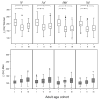Effects of Aging on Vocal Fundamental Frequency and Vowel Formants in Men and Women
- PMID: 28864082
- PMCID: PMC5832520
- DOI: 10.1016/j.jvoice.2017.08.003
Effects of Aging on Vocal Fundamental Frequency and Vowel Formants in Men and Women
Abstract
Purpose: This study reports data on vocal fundamental frequency (fo) and the first four formant frequencies (F1, F2, F3, F4) for four vowels produced by speakers in three adult age cohorts, in a test of the null hypothesis that there are no age-related changes in these variables. Participants were 43 men and 53 women between the ages of 20 and 92 years.
Results: The most consistent age-related effect was a decrease in fo for women. Significant differences in F1, F2, and F3 were vowel-specific for both sexes. No significant differences were observed for the highest formant F4.
Conclusions: Women experience a significant decrease in fo, which is likely related to menopause. Formant frequencies of the corner vowels change little across several decades of adult life, either because physiological aging has small effects on these variables or because individuals compensate for age-related changes in anatomy and physiology.
Keywords: Adult acoustics; Aging voice; Formants; Fundamental frequency; Sex differences.
Copyright © 2018 The Voice Foundation. Published by Elsevier Inc. All rights reserved.
Figures



Similar articles
-
Corner vowels in males and females ages 4 to 20 years: Fundamental and F1-F4 formant frequencies.J Acoust Soc Am. 2019 Nov;146(5):3255. doi: 10.1121/1.5131271. J Acoust Soc Am. 2019. PMID: 31795713 Free PMC article.
-
Effect of Ageing on Acoustic Characteristics of Voice Pitch and Formants in Czech Vowels.J Voice. 2021 Nov;35(6):931.e21-931.e33. doi: 10.1016/j.jvoice.2020.02.022. Epub 2020 Mar 31. J Voice. 2021. PMID: 32245663
-
Source and Filter Acoustic Measures of Young, Middle-Aged and Elderly Adults for Application in Vowel Synthesis.J Voice. 2024 Mar;38(2):253-263. doi: 10.1016/j.jvoice.2021.08.025. Epub 2021 Oct 28. J Voice. 2024. PMID: 34756498
-
The aging voice.Semin Speech Lang. 1997 May;18(2):159-68; quiz 168-9. doi: 10.1055/s-2008-1064070. Semin Speech Lang. 1997. PMID: 9195688 Review.
-
Anaesthesia for the aging patient.Can J Anaesth. 1993 May;40(5 Pt 2):R63-73. doi: 10.1007/BF03020686. Can J Anaesth. 1993. PMID: 8500214 Review. English, French. No abstract available.
Cited by
-
Subclinical articulatory changes of vowel parameters in Korean amyotrophic lateral sclerosis patients with perceptually normal voices.PLoS One. 2023 Oct 13;18(10):e0292460. doi: 10.1371/journal.pone.0292460. eCollection 2023. PLoS One. 2023. PMID: 37831677 Free PMC article.
-
Age-Related Changes in Speech and Voice: Spectral and Cepstral Measures.J Speech Lang Hear Res. 2020 Mar 23;63(3):647-660. doi: 10.1044/2019_JSLHR-19-00028. Epub 2020 Feb 25. J Speech Lang Hear Res. 2020. PMID: 32097060 Free PMC article.
-
Static measurements of vowel formant frequencies and bandwidths: A review.J Commun Disord. 2018 Jul-Aug;74:74-97. doi: 10.1016/j.jcomdis.2018.05.004. Epub 2018 Jun 1. J Commun Disord. 2018. PMID: 29891085 Free PMC article. Review.
-
Influence of vocal and aerodynamics aspects on the voice-related quality of life of older adults.J Appl Oral Sci. 2020;28:e20200052. doi: 10.1590/1678-7757-2020-0052. Epub 2020 Aug 17. J Appl Oral Sci. 2020. PMID: 32813841 Free PMC article.
-
Acoustic and Natural Language Markers for Bipolar Disorder: A Pilot, mHealth Cross-Sectional Study.JMIR Form Res. 2025 Apr 16;9:e65555. doi: 10.2196/65555. JMIR Form Res. 2025. PMID: 40239203 Free PMC article.
References
-
- Rendall D, Kollias S, Ney C, Lloyd P. Pitch (F0) and formant profiles of human vowels and vowel-like baboon grunts: The role of vocalizer body size. J Acoust Soc Am. 1995;117:944–955. - PubMed
-
- Torre P, Barlow JA. Age-related changes in acoustic characteristics of adult speech. J Commun Disord. 2009;42:324–333. - PubMed
-
- Stathopoulos ET, Huber JE, Sussman JE. Changes in acoustic characteristics of the voice across the life span: measures from individuals 4–93 years of age. J Speech Lang Hear Res. 2011;54:1011–1021. - PubMed
-
- Rastatter MP, Jacques RD. Formant frequency structure of the aging male and female vocal tract. Folia Phoniatr Logo. 1990;42:312–319. - PubMed
MeSH terms
Grants and funding
LinkOut - more resources
Full Text Sources
Other Literature Sources
Medical
Miscellaneous

